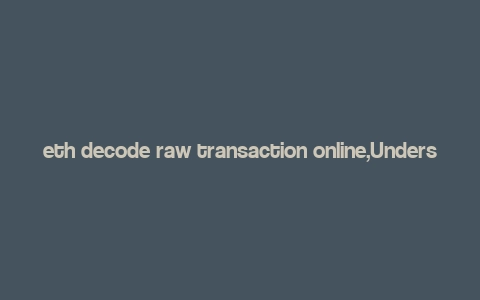Understanding and Decoding Raw Ethereum Transactions Online
Decoding raw Ethereum transactions can be a daunting task, especially for those new to the world of blockchain and cryptocurrencies. However, with the right tools and knowledge, you can easily decode and understand the intricacies of these transactions. In this article, we will guide you through the process of decoding raw Ethereum transactions online, providing you with a comprehensive overview of the process and the tools available.
What is a Raw Ethereum Transaction?
A raw Ethereum transaction is a hexadecimal string that contains all the necessary information for a transaction to be processed on the Ethereum network. This includes the sender’s address, recipient’s address, amount of Ether to be transferred, gas price, gas limit, and data payload (if any). Decoding this raw transaction allows you to understand the details of the transaction and verify its authenticity.
Tools for Decoding Raw Ethereum Transactions
There are several online tools available that can help you decode raw Ethereum transactions. Some of the most popular ones include:
| Tool | Description |
|---|---|
| Etherscan | A comprehensive blockchain explorer for Ethereum, offering a wide range of tools for analyzing transactions, including a raw transaction decoder. |
| Blockchair | Another popular blockchain explorer that provides detailed information about Ethereum transactions, including a raw transaction decoder. |
| MyCrypto | A cryptocurrency wallet and explorer that offers a raw transaction decoder as part of its suite of tools. |
These tools are user-friendly and require no technical expertise to use. Simply paste the raw transaction into the decoder, and the tool will provide you with a detailed breakdown of the transaction’s components.
Decoding the Transaction
Once you have selected a tool and pasted the raw transaction, the decoder will break down the transaction into its individual components. Here’s a breakdown of the key elements you’ll encounter:

- Sender Address: The address of the person or entity initiating the transaction.
- Recipient Address: The address of the person or entity receiving the transaction.
- Value: The amount of Ether being transferred in the transaction.
- Gas Price: The price per unit of gas that the sender is willing to pay for the transaction to be processed.
- Gas Limit: The maximum amount of gas that the transaction is allowed to consume.
- Nonce: A number that ensures the transaction is unique and has not been previously used.
- Input: Data payload, if any, that the sender wants to include with the transaction.
Understanding these components will give you a clear picture of what the transaction entails and whether it has been processed successfully.
Verifying the Transaction
After decoding the transaction, it’s essential to verify its authenticity. Here are a few steps you can take to ensure the transaction is legitimate:
- Check the Transaction Hash: The transaction hash is a unique identifier for the transaction. You can verify the transaction by searching for its hash on a blockchain explorer and comparing the details provided with the decoded transaction.
- Examine the Block Number: The block number indicates the block in which the transaction was included. You can verify this by checking the block explorer for the corresponding block number.
- Review the Transaction Fee: The transaction fee is calculated based on the gas price and gas limit. Ensure that the fee matches the expected amount for the transaction’s complexity.
By following these steps, you can be confident that the transaction is genuine and has been processed on the Ethereum network.
Conclusion
Decoding raw Ethereum transactions online is a valuable skill for anyone interested in understanding the inner workings of the Ethereum network. By using the right tools and following the steps outlined in this article, you can easily decode, verify, and analyze Ethereum transactions. Whether you’re a cryptocurrency enthusiast, developer, or simply curious about blockchain technology, decoding raw Ethereum transactions will provide you with a deeper understanding of the world of cryptocurrencies.